Indian press and Socio-cultural and Religious Transformation in Colonial Rule of 19th and 20th Centuries: A New Perspective – National Seminar held at Nagarjuna University, Ongole Campus [2]
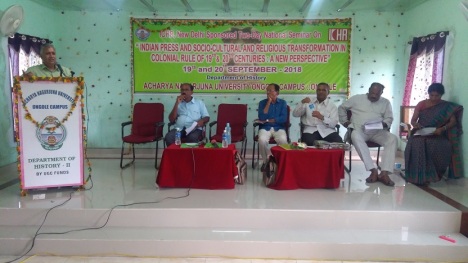
The first day [19-09-2018] seminar proceedings continued (3.00 to 4.00 pm): After lunch, the paper reading session started with the paper presentation of G. Anjaiah, K. Maddaiah, P. C. Venkatasubbaiah, G. J. Sudhakar, A. Madhusudhana Rao, and Savitri. G. J. Sudhakar had chaired the session.
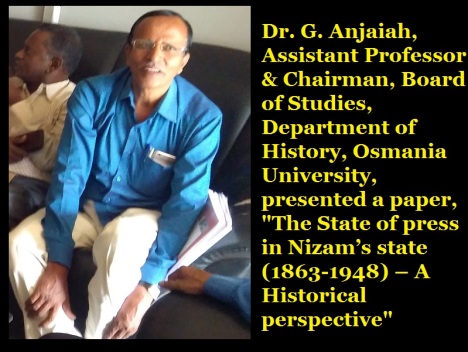
Anjaiah[1] – The State of press in Nizam’s state (1863-1948) – A Historical perspective: The Asafjahi State was founded by Nizam-ul-Mulk in the year 1724CE. He and his successors ruled most parts of present two Telugu speaking states and some portions of Maratwada region, Kannada region. The Long rule of Asafjahis if known in the history of Colonial times for its achievements and some anti-people activities. The Nizam-British relations between 1798-1857 & 1858-1948 contributed to the growth of modern education in this region, Telugu, Urdu are the two major languages of the majority people of the Nizam’s State. But when the Social reformers and scholars started number of journals, newspapers (weekly or monthly) in British India, in Nizam State the freedom of press was completely suppressed by the State. The establishment Vignanachandrika Mandali, , Srikrishnadevaraya Bashamdramilayam, the Marati Mandal, Andhrasaraswatha Parishat etc gave a new direction to press in Nizam State. The Autocratic Anti-Civil Policies/Farman’s of Last Two Nizam’s were challenged by the intellectuals of this region. The editors of Local papers like Golkonda Patrika, Rayyat (Mamndumula Narsing Rao), Imroz, Siyasat, Nilagiri, openly criticised the anti-people policies of Nizam. Their writings covering the gloomy condition of Peasants, Women, atrocities of landlords, inspired the common public to revolt against State.
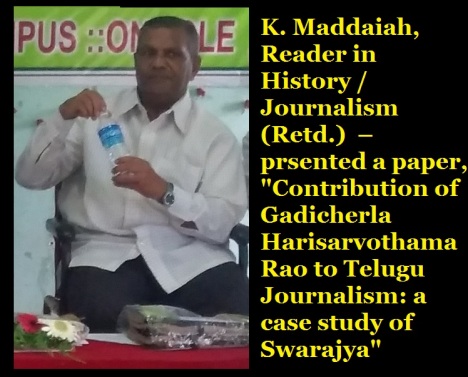
Maddaiah[2] – Contribution of Gadicherla Harisarvothama Rao to Telugu Journalism: a cae study of Swarajya – A Telugu daily: Gadicherla Harisarvothama Rao (1883-1960), popularly known as Andhra Tilak, was a doyen among the freedom fighters in pre-Gandhian era and a fearless journalist in the erstwhile Madras Presidency. He was a multifaceted personality. During the Vandemataram Movement in 1907, he was the first student of Government Training College, Rajahmundry to be rusticated. Harisarvothama Rao wrote an editorial under the heading, “Vipareetha Buddhi” (Strange Proceedings), condemning the action of the Englishman in his journal Swarajya of 26 March 1908, wherein he said that the cruel English tiger had devoured two Indians. For his editorial in “Swarajya” dated 26 March,1908, he was sentenced to three years imprisonment(1908-1911). He was the first Telugu Editor to suffer the most inhuman treatment in Vellore jail. He was also associated with Library Movement and Adult Education. Harisarvothama Rao promoted the publication of several journals solely with a view to carrying forward the message of national independence and spreading literacy among the adults.
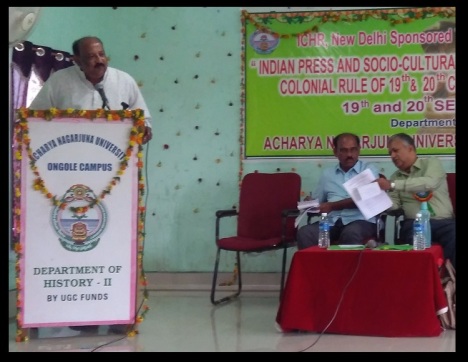
Madhusudhana Rao[3] – A Critical study of Raja Ram Mohan Roy, Christian missionsries and social reformation: It was a joint paper of Madhusudhana Rao and K. V. Ramakrishna Rao[4], and Madhusudhana Trao presented. In Indian history, even in just past-history, many details are not known to all, as only selective details are printed and circulated for the selected audience. Most of the facts, details and information are hidden from the general public. About the social reformation, societal transformation and public progress, even revealed details have also been subjected to bias, prejudice and manipulated processes. In the case of Ram Mohun Roy, later became “Raja,” many details have been suppressed and only partial information has been presented to the public, as if he has been only a reformer, abolisher of sati, child marriage and so on. Though, such benevolent and beneficial services are acknowledged, why other facts have been suppressed is intriguing.Though, more and more books are published, research papers presented and published, such suppressed facts are not brought out, is not known. Thus, how and why, he happened to be associated with such reformative actions has to be studied critically. In fact, here in the context, abolition of Sati etc., the reformative actions were enforced only through Act. Thus, as even, in legal parlance, it is emphasized the dictum, “Audi alteram partem.” It is a Latin phrase meaning “listen to the other side”, or “let the other side be heard as well”. In fact, Bengal was also under “dual control”, when Shah Alam II, the Emperor of Delhi granted the charter of Bengal, Bihar and Orissa to the East India Company in 1765, he Indian subjects were playing double fiddles to two masters. Thus, the other side of the historical narrative is critically analyzed in this paper.
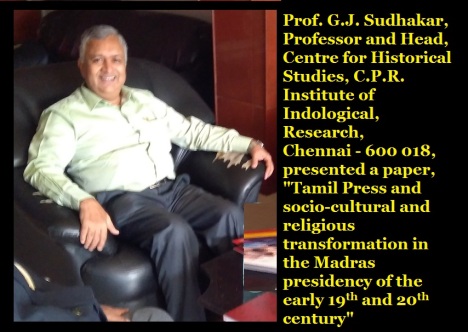
G. J. Sudhakar[5] – Tamil Press and socio-cultural and religious transformation in the Madras presidency of the early 19th and 20th century: The introduction of English education, establishment of the Universities, Courts and Government administration by the British made changes in the social life of people. New schools and colleges were established for imparting English education. The Brahmins were the first to make use of the opportunity to get English education which was a passport for gaining employment in the British Government. The growth of English education led to the emergence of the Brahmins as an important community with a superior status in the social hierarchy. The social struggle witnessed by the nineteenth century was a resistance offered simultaneously against the ideological beginning of the British Colonial rule and traditional social and cultural order. With the spread of the western ideas came the awareness of the weakness of the traditional order and the irrelevance of ritual activities. The birth of modern ideas under colonialism influenced the educated people to understand the social and political evolution of India in a new perspective. In different parts of the country, these ideas came up through different movements. The nineteenth century saw the emergence of a number of social movements, which sought to reform and regenerate Indian traditional institutions. In the beginning of the twentieth century, communal conflicts occurred between the Brahmins and non-Brahmins, especially in the Tamil region. The Brahmins had preponderance in the Home Rule League, and they used the Home Rule Movement for sustaining their power and prestige in the society. The strength of their population during the colonial period was 3.3 percent of the total population. However, 3.3 percent of the population held 93 percent of the official positions in the government during the period of British administration. Thus, this period witnessed the birth of communal politics and the Dravidian press leading to an ideological war between the nationalists and the communal politicians. The Dravidian Press championed the cause of the representation of people marginalized in the Brahmin dominated Tamil society and it supported the British administration.
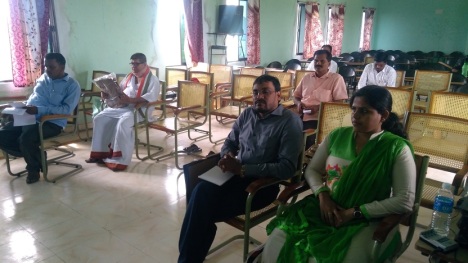
4.10 to 5.20 pm: V. Sudharshan chaired the scond session. Victor Babu, M. Deendayal and Gangaiah presented papers.
4.10 to 4.25 pm – V. Sudharshan[6]: He presented a paper, “Colonial epoch press at Rajamundta – A study”: The major newspapers in the British India are The Indian Mirror, The Bombay Samachar, and The Hindu Patriot, The Amrita Bazar Patrika, Rayet, The Hindu, The Kesari, The Bengalee, The Huriara. The Bengali Public Opinion, The Reis and The Samprokash, The Sulabh Samachar, The Hitavadi, The Induprakash, The Swadeshimitran, The Advocate of Lucknow, The Herald of Bihar are really noteworthy. By 1875, there was phenomenal growth of newspapers in India which rose to 475 in number. These newspapers created awareness among the masses of India about the need to be united and to act with one voice to achieve their goal of freedom from foreign yoke. Bipan Chandra observes that in the period from 1870 to 1918, powerful newspapers emerged under distinguished and fearless nationalists. The influence of the press extended far beyond its literate subscribers. Their influence was not limited to cities and large towns. Along with newspapers, library movement also kindled the spirit of nationalism and political participation on a large scale.
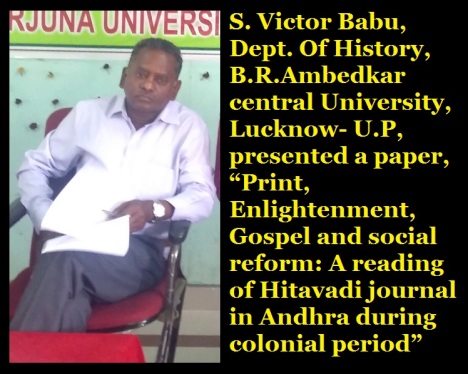
4.25 to 4.40 pm – S. Victor Babu[7]: He presented a paper, “Print, Enlightenment, Gospel and social reform: A reading of Hitavadi journal in Andhra during colonial period” – It is well known that it was Christian missionaries who started the printing work in different regions and languages. In the same way, printing technology was also brought to Andhra region at the initiative of missionaries. Once the press arrived, it played an important role in spreading the progressive ideas in the social and political spheres in Andhra. The Christian journals, no doubt, had the objective of spreading religion as it was their primary concern. In the process, they also critiqued some aspects of Hindu religion. As a result various aspects of religious, social and cultural issues came under attack of these journals. However, these journals also took up various issues which are aimed at reforming the society. It was assumed that most journals published by missionaries had single agenda of critiquing Hindu religion. But a close reading of these journals reveal that besides criticism of religious issues, they also took up cudgels against social evils in the society. Edmond Sharkey of Machilipatnam started Hitavadi in 1848 and continued upto 1862, nearly 14 years. This journal took up various religious, social and cultural issues. Many of the issues raised in these kind of journals were taken up by social reformers later like K. Veeresalingam. Therefore, this paper argues that missionary journals also took up the issues of social reforms and not only efforts to promote their religion.
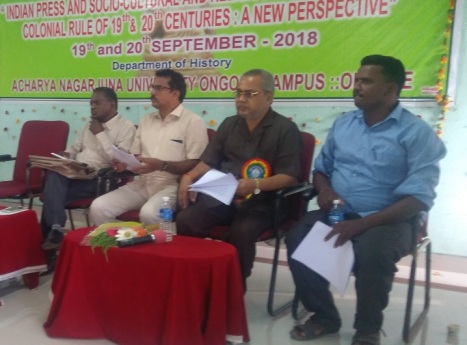
4.40 to 4.55 pm – M. Deen Dayal[8]: He presented a paper on “The role of press in Indian National movement”. The development of a free press is one of the notable features of the nineteenth century awakening generally known as Bengal Renaissance. To view the modern Indian press as a lineal descendant of the medieval news-letters of the Mughal age produced by the official class of waqianavis, would be nearly as good as to compare modern chemistry with medieval alchemy. In a real sense the modern press is a gift of the West to India and it served, to use the expression of Karl Marx, a “new and powerful agent of reconstruction” of modern Indian Society and culture. The initiative in the field had come from the English settlers in the land to whom it was a long established tradition. The Indians were not slow to grasp the significance and realize the possibilities of the new development.1 By the second and third decades of the nineteenth century quite a few among them including men of real talent and caliber had taken to journalism often with remarkable success. They had discovered in the press a novel and powerful weapon to wage war in favour of their ideologies – the reformers vehemently attacking age-old conventions through it and the conservatives desperately defending them. The language of agitational politics was born and criticism of the establishment, however mild, found systematic expression. Notwithstanding this, the then ruling authorities had, sought to visit the dreaded fourth estate with repressive measures to check its liberty.2 It required a prolonged struggle entailing the sacrifices of many to restore it to its normal status of freedom. The sunshine of official favour was however short-lived. About two and a half decades later the great rebellion of 1857 had shaken the foundation of the East India Company’s rule in India and thrown the administration into total disorder. The authorities had become extremely suspicious of the press and led them once more to apply the gag on it, though the educated Indian middle class had never supported the rising. These vicissitudes in the early career of the press form one of the most fascinating chapters in the history of modern India

4.55 to 5.20 pm – Gangaiah : He presented a paper on the role of the contribution of Christian missionaries in the colonial press. He mentioned about James Augustus Hickey and differentiated between missionary press and colonial press. Through press only, the missionaries played a role so that the British introduced western education that was opened to all without any caste discrimination. Without the British and Christian missionaries, India would not have been transformed.

20-9-2018 – the second day proceedings: On the second day, in the first session, Aravind Kumar, B. Ramachandra Reddy, Pareswar Sahoo,…….. and Sudha Rani. Sudha Rani chaired the session.
10.11 to 10.27 am – Aravind Kumar[9]: He presented a paper, “The role of Telugu press in the Hyderabad state freedom struggle”. The press has played a crucial role in the Indian National Movement. Manfred Lohman states that Journalists and political writers became important carriers of dynamism in the process of socio and political change in India. The Press had played a decisive role in national movement. It has emerged as a powerful force in the modern age. It is described as ‘Fourth Estate’ of the society. The news papers inform, enlighten and inspire the people. R.C. Mujumdar writing about the contribution of the press to the Indian freedom struggle remarks that “the press imbibed the people with patriotic fervour, indomitable courage and heroic sacrifice and extraordinary degree”. The Newspapers rendered invaluable service by arousing national consciousness among the people. In the liberation of Hyderabad State, the press played an important role. Several newspapers in local languages paved for the awakening of the people. The latter half of the 19th century was characterized by vigorous journalistic activity in Hyderabad and number of newspapers and journals in Urdu, Telugu, Marathi, and English were started during this period. A new development of this period was the birth of the newspapers.1 Newspapers are rightly regarded as the fourth estate. Though Hyderabad was a princely state and sovereignty was claimed by the Nizam, the rulers of the state, Among such public institutions, the most important were the newspapers, which arose in a large number due to the spread of political consciousness.2 This political awakening and the significant role of Hyderabad journalism is the result of gradual, sincere, and silent contributions of those teachers, Scholars, Lawyers and Philanthropists who tried their level best to spread knowledge among their people. Newspapers were the effective media between the ruler and the masses. This indicated that along with Urdu speaking people, the Telugu, Marathi, and Kannada speaking people also were politically conscious enough to express their views. The Press exposed the yawning gap between the privileged and unprivileged. While explaining the object poverty of poor masses, they highlighted the extravagance of the ruling class and its coterie. An attempt is made in the present paper the significant role played by the Telugu language press in bringing enlightenment in the minds of the people of Hyderabad state, paved the way for freedom struggle against the autocratic rule of the Nizam government. The Telugu newspapers strived to spread the ideas of nationalism; they were simple in style, soul, stirring, had an emotional appeal and created a real political movement.
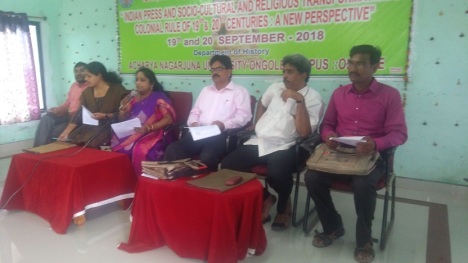
10.28 to 10.52 am – B. Ramachandra Reddy[10]: Prostitution was a melody of the Indian society from time immemorial. All dancing girls were generally treated as prostitutes though many prostitutes were not nautch girls. The nautch, initially started with the practice of dedicating women to one of the Hindu divinities, became a recognized form of social entertainment. It was performed formerly by a class of proficient dancers who took it as a family profession known as ‘Bogams’ and ‘Sanis’. Their services were in great demand at social gatherings of the higher classes. After the collapse of the traditional aristocracy and loss of patronage, the women of the community to earn a living, strayed into the lucrative path of prostitution and sold themselves for money for promiscuous intercourse. Girls from various castes were also bought to introduce them to the profession of prostitution. The nineteenth century social reformers of Telugu region like K. Veeresalingam and R. Venkataratnam Naidu were very active in raising their voice against the abominable activities of nautch girls. By 1894 the nautch question received the attention of progressive sections in the society. The reason for the growth of opposition and feeling against the patronage of nautch girls was that their profession was closely associated with prostitution. The feeling had gathered strength in course of time and the institution had begun to be openly condemned. People were urged not to attend nautch performances and the girls themselves were asked to abandon their wayward life and enjoy the bliss of matrimony. The growing concern over moral issues and purity in life added much fuel to strengthen the movement. In the second decade of the twentieth century the propaganda efforts against the practice of nautch and prostitution increased. A number of dramas were written and enacted highlighting the harmful repercussions of prostitution.
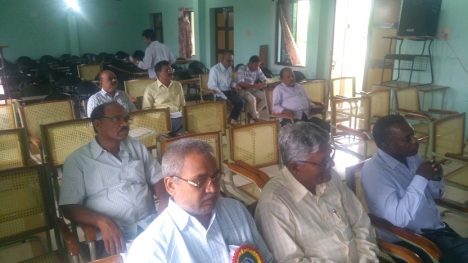
10.53 to 11.10 am – Paraeswar Sahu[11]: The 19th century history of Odisha was influenced a lot by mass media and journalism because; it was the urgency of the social transformation in the society, particularly among the women community and the backward people to gain freedom and right from the British yoke. It is noticed from the archival sources and the British records that during the colonial period in Odisha from 1803 to 1947 the masses were illiterate, economically backward, socially stagnant and conservative attitude. Therefore, not only the women but also the downtrodden were deprived of the social connectivity of the freedom movement. This precarious social condition was lively described in the `writings of Fakir Mohan Senapati e.g. the Revati and Lachhama. In the novel the Revati three words prompted by the grandmother like lo Revi, (Revati, nice of the grandmother) lo Nian (the Fire), .lo Chuli (a mud place where cooking is made) proves that how the society was under the social nail. Here Revati is the central character in the novel the Revati. Due to a girl she has been deprived of education and her grandmother said education is meaningless unless and until to know cooking. Therefore the grandmother said lo Revati you are meant for fire, fire land. It says that in 18th and 19th century social transmission was very slow and callous. As a result the press and Journalism of Satyabadi School, in Puri district of Odisha acts as a torch bearer to promote the nationalist history and the concept of social transformation in the society. The Satyabadi School in Puri district of Odisha was established by Pandita Gopabandhu Das, the pioneer of the Panchasakha Movement in modern times. The Panchasakhsa were Pandita Gopabandhu Dash, Acharya Harihar Dash, Godabarish Mishra, Krupasindhu Mishra and Pandita Nilakantha Dash. They were the beacon of the light with a commitment to evacuate darkness from the socio- economic and political life of Odisha.
11.11 to 11.40 am – Sudha Rani: She strssed the points of Adapa Satyanarayana and urged that the dalits should be liberated.
K. V. Ramakrishna Rao
28-09-2018
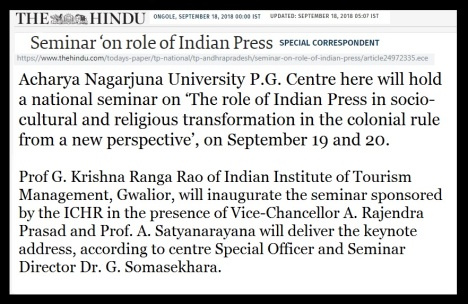
[1] Dr. G. Anjaiah, Assistant Professor & Chairman, Board of Studies, Department of History, Osmania University
[2] Dr. K . Maddaiah, M.A., P.hd., PGDCJ. Reader in History / Journalism (Retd.) 34/28-29, Peta, Kummari Street, Kurnool – 518001. (A.P),Cell no: 9951121036. E-mail: kurubamaddaiah@gmail.com
[3] Dr A. Madhusudhana Rao, HOD, History Department, Sri Govindaraja Swami Arts College, Tirupati.
[4] K.V. Ramakrishna Rao I.R.S, Independent researcher, Former visting faculty, NACIN, Chennai.
[5] Prof. G.J. Sudhakar, Professor and Head, Centre for Historical Studies, C.P.R. Institute of Indological, Research, Chennai – 600 018
[6] Dr. V.SUDARSHAN, Reader, Head Dept of History, V.S.M College (Autonomous), RAMACHANDRAPURAM (E.G) A.P, Mobile:9885242037, Email : dr.veepuri123@gmail.com
[7] Prof. S.VICTOR BABU, Dept. Of History, B.B.Ambedkar central University, Lucknow- U.P
[8] Dr. M. Deenadayal, Academic Consultant, Department of History, S.V.U. College of Arts, S.V. University, Tirupati, E-mail:makaladeenadayal@gmail.com., Cell No.09490922867
[9] Dr. Aravind Kumar, Dravidian University, Kuppam – 517426, Mobile: 9391029522, Email:aravindrao46@gmail.com
[10] Dr. B. Rama Chandra Reddy, Associate Professor, Department of History, KMCPG Studies, Puducherry- 8
[11] Dr. Pareswar Sahoo, Asst. Professor in History, S.B. Women’s (Auto) College, Cuttack
Filed under: Acharya, ambedkar, andhra, anti-brahman, anti-brahmin, archaeology, Ariyar, censor, censorship, colonial, columnist, conference, constitution, control, controversy, daily, dalit, draconian law, Dravida, Dravidam, dravidar, Dravidian, editor, editorial, fake news, freedom of press, freedom of thought, gandhi, history, journal, language, nation-state, nationalism, nationality, newspaper, periyar, press, press council, print media, prostitution, protest literature, publisher, puducherry, regionalism, research, research paper, researcher, rewriting, scholar, sedition, telengana, telugu, writer | Tagged: Andhra, censor, colonial, colonial press, colonial rule, colonialism, control, defamation, defame, fake news, freedom of press, freedom of thought, media, Nagarjuna, nagarjuna University, news, newspaper, ongole, press, press council, print, printing press, PTI, sedition, seemandhra, telengana | Leave a comment »

